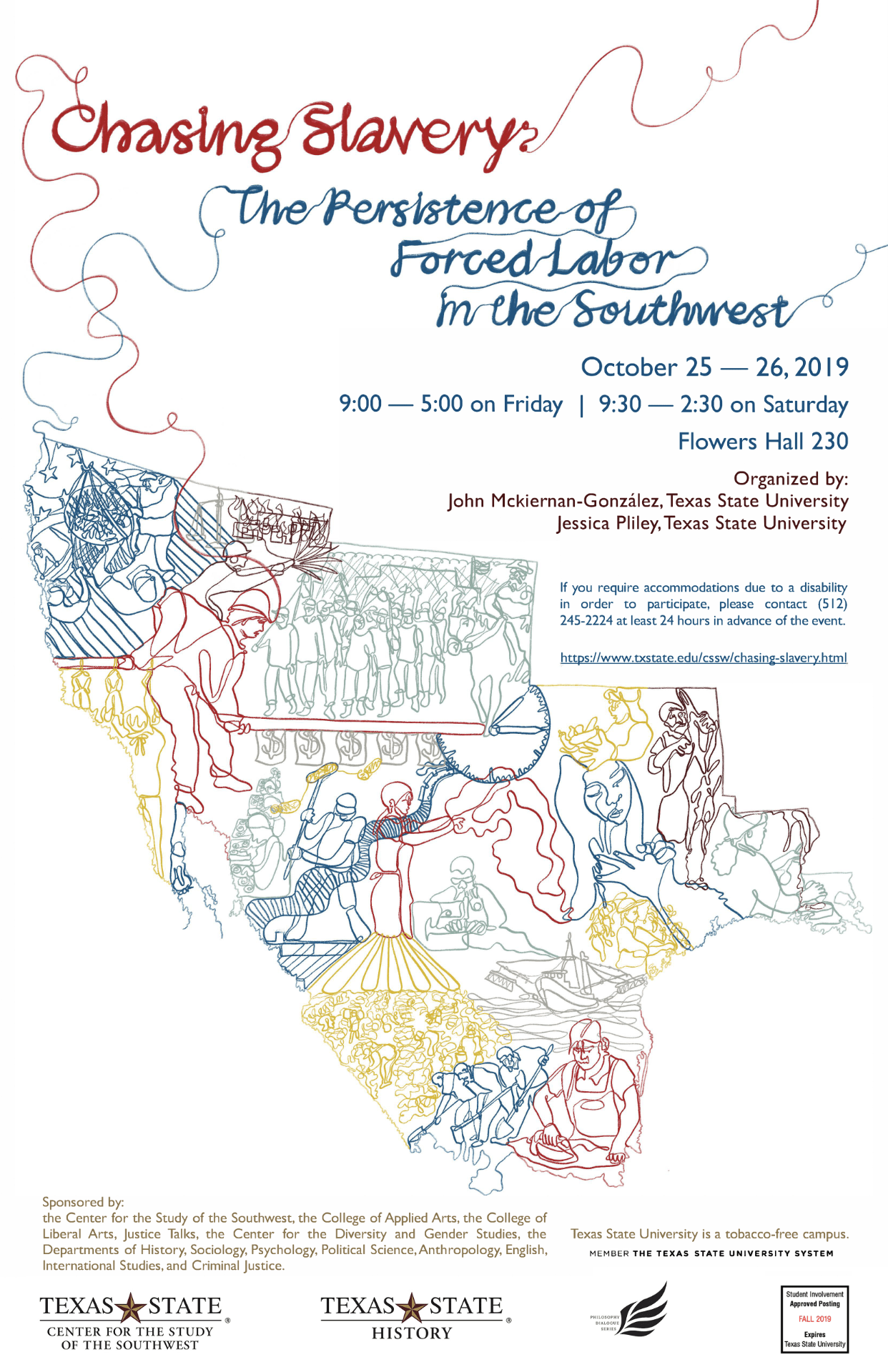
In preparation for the upcoming symposium, Chasing Slavery: The Persistence of Forced Labor in the Southwest, to be held at Texas State University from 24-26 October, in Flowers Hall 230, we will be running a series of posts focused on the conference participants and organizers. The conference will bring together dozens of scholars, with a keynote from Ambassador Luis C.deBaca (ret.). See the conference website for more details.
Today, conference co-organizer Dr. Jessica Pliley, Associate Professor of the History of Women, Genders, and Sexualities at Texas State University, helps introduce the conference for our readers. She can also be found on Twitter.
Give us your elevator pitch for the conference. What is it about?
Dr. Jessica Pliley: This conference tackles the question of the various ways that forced labor has persisted in the US after emancipation. My interest in this topic was born out the research I conducted for my first book, Policing Sexuality: The Mann Act and the Making of the FBI. While I was deep in the investigative case files of the FBI looking for cases of investigations into violations of the 1910 White Slave Traffic Act, I regularly encountered investigations into cases of peonage in the American South. After my book was published in 2014, I became more involved in international conversations occurring among scholars thinking about trafficking and forced labor, which led me to co-organize the Working Group on Modern Slavery and Trafficking at Yale University. That two-year working group considered the ways that history can and should shape our understandings of the development of liberal political economy that is predicated on unfree labor. Partnering with the Center for the Study of the Southwest allows me to look at the ways that forced labor persisted in a discrete region—the borderlands of the Southwest. This conference aims to being together historians, sociologists, and other scholars to consider the different sites of persistent labor abuse, while attending the ways that race, ethnicity and gender shape that abuse. The other aim of the Chasing Slavery project that excites me is more pedagogical. John Mckiernan-González and I are co-teaching a graduate seminar that features the writings of many of the participants of the conference. By hosting this conference, we are providing our students a unique opportunity to meet the scholars whose ideas they have been substantively engage with in class.
 What was the most surprising thing you’ve encountered when considering forced labor?
What was the most surprising thing you’ve encountered when considering forced labor?
Dr. Pliley: I am consistently struck by the routine quality of extreme labor exploitation. In many ways it hides in plain view, both historically and now. It is almost impossible to find products with supply chains that are clean of labor exploitation. Everything from the tea we drink to the fast fashion we wear is produced through extreme labor exploitation. Until workers’ voices are more firmly incorporated into accountability schemes, I fear this will remain the case.
What do you hope people will take away from our conference on trafficking, forced labor and labor exploitation?
Dr. Pliley: I hope the conference will prompt attendees to look at work in new ways. I also hope that it will lead to dynamic conversations among the attendees.
What challenge(s) raised by your research are you still trying to reconcile?
Dr. Pliley: I struggle with the dominance of contractual thinking as it pertains to ‘labor’. Often times reformers will argue that the solution to poor working conditions is a better contract. But when you look at the history of contracts it becomes clear that large swaths of people, like women and people of color—the very same people who are most vulnerable to labor exploitation—were excluded from liberal contract theory. And instead the work these people labored at became racialized and gendered to justify unfree, uncompensated or poorly-compensated work. In my own area of expertise of intimate labor, the question revolves around the paradox of intimate labor. In tradition liberal thinking, laboring is a public act that can come under the protections of a contract, yet work that is intimate labor—child care, elder care, domestic labor, wifely labor, sex work—is often done in private domains of the family outside of public view.
Also, I am endlessly vexed and fascinated by the ways that extreme labor exploitation has been conflated with trafficking under the rubric of modern slavery. Like many other scholars, I am deeply critical of the use of the term “slavery,” yet I find myself bound be the term. Again and again, historical actors pulled on the evocative power of the metaphor of “slavery” to describe their own experiences or to agitate for reform. Yet, the term slavery can have a conflating effect, on the one hand, while also dismissing the horrors of chattel slavery, on the other hand. Furthermore, once ideas of trafficking get introduced into the mix, what I find is a general lack of precision about the specific abuses, processes, and choices people have faced and continue to face. I am hoping that our conversations at the conference will help me find a better vocabulary to describe the practices associated with forced and coerced labor.
Also check out:
- Policing Sexuality: The Mann Act and the Making of the FBI
By Dr. Jessica Pliley (Harvard University Press, 2014) - Global Anti-Vice Activism, 1890–1950 Fighting Drinks, Drugs, and ‘Immorality’
Edited by Drs. Jessica Pliley, Robert Kramm, and Harald Fischer-Tiné (Cambridge University Press, 2016)
